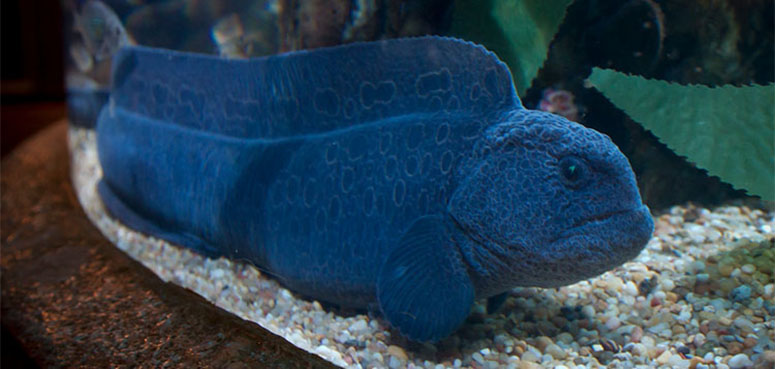When it comes to identifying aquatic animals, eels seem like a no-brainer thanks to their distinguishable long, slender bodies.

From left to right: wolf eel, monkeyface eel and green moray eel. Photos courtesy of Aquarium of the Bay
By Mallory Johnson
Published: September, 2016
When it comes to identifying aquatic animals, eels seem like a no-brainer thanks to their distinguishable long, slender bodies. But are these slithery animals really as easy to identify as we think? Despite the common notions about eels, some of these animals are more deceptive than you might realize.
Wolf Eels
Wolf eels may look like, and even be named like an eel, but don’t let that fool you. Wolf eels are not true eels but are rather part of the Anarchichadidae or “wolffish” family. Some of the features that distinguish a wolf eel from a true eel are the presence of pectoral fins behind the head and covers over the gills.
Wolf eels have sharp canine teeth and very powerful jaws that come in handy at mealtime. Wolf eels typically dine on hard-shelled invertebrates such as clams, mussels and sea urchins. Their strong jaws and sharp teeth help them crack open or crush shells to get to the meat inside.
The coloring of a wolf eel changes dramatically through its lifetime. As juveniles, wolf eels are vibrant orange, and can be found in shallow subtidal zones. As they grow, however, this animal loses its bright colors and turns gray with dark spots and blotches to provide camouflage as it adapts to deeper water habitats. Wolf eels are typically found in cold waters along the Pacific coast of North America, ranging from Alaska to the northern tip of Baja.
Wolf eels are very loyal animals, and when they pick a partner, it’s for life. Around the age of four, wolf eels pair up with a mate and find a nice cave to inhabit for the rest of their days, only leaving to forage for food or if forced out by a larger animal, such as an octopus.
Monkeyface Eels
Once again, this “eel” is a deceptive one. Despite its long, slender body and its name, the monkeyface eel is part of the prickleback family. Monkeyface eels boast the same pectoral fins and gill covers as the wolf eel.
Monkeyface pricklebacks can be found in habitats from southern Oregon, along the California coast and down to the northern part of Mexico. These fish are generally found within intertidal zones, where there are plenty of rocky areas to hide. One impressive feat of the monkeyface eel is its ability to survive out of water for over 24 hours, as long as it stays moist.
Like the wolf eel, monkeyface eels typically only leave home to forage for food. As juveniles, monkeyface eels munch on small crustaceans and zooplankton. Their eating preferences begin to change as they mature, however, and adult monkeyface eels suddenly become herbivores, preferring to dine on a variety of algae instead.
Green Moray Eels
Finally, an eel that is in fact a true eel! Unlike the wolf eel and the monkeyface eel, moray eels lack pectoral fins and gill covers. However, just because these are true eels doesn’t mean their name is still not deceiving. Green moray eels are actually brown. This eel secretes yellow mucus all over its body to protect it from parasites and diseases, giving this animal the illusion of being green.
Moray eels look intimidating thanks to the way they constantly open and close their mouths. Despite the menacing look this movement gives them, it’s actually more of a survival technique than an invitation for a fight; they do this to pump water through their gills for respiration.
Green moray eels have long, slender bodies that are flattened from side to side. Moray eels have a particular shape that prohibits them from swallowing in the same manner that most other fish do. Instead, as a true eel, moray eels have two sets of jaws; a powerful outer jaw and a second, inner pharyngeal jaw located inside the throat. When dinnertime rolls around, the moray eel will clamp down on its prey with its first set of jaws. Meanwhile, its pharyngeal jaw will protrude from its throat to grab the food and carry it back down, all within a fraction of a second.
You can visit the green moray eel, and the two imposters, in person at Aquarium of the Bay. Test out your newfound knowledge and see if you can spot the defining features of a true eel. Find out more at www.aquariumofthebay.org.
Mallory Johnson is the Communications Manager at Aquarium of the Bay, a nonprofit dedicated to protecting, restoring and inspiring the conservation of San Francisco Bay and its watershed.

